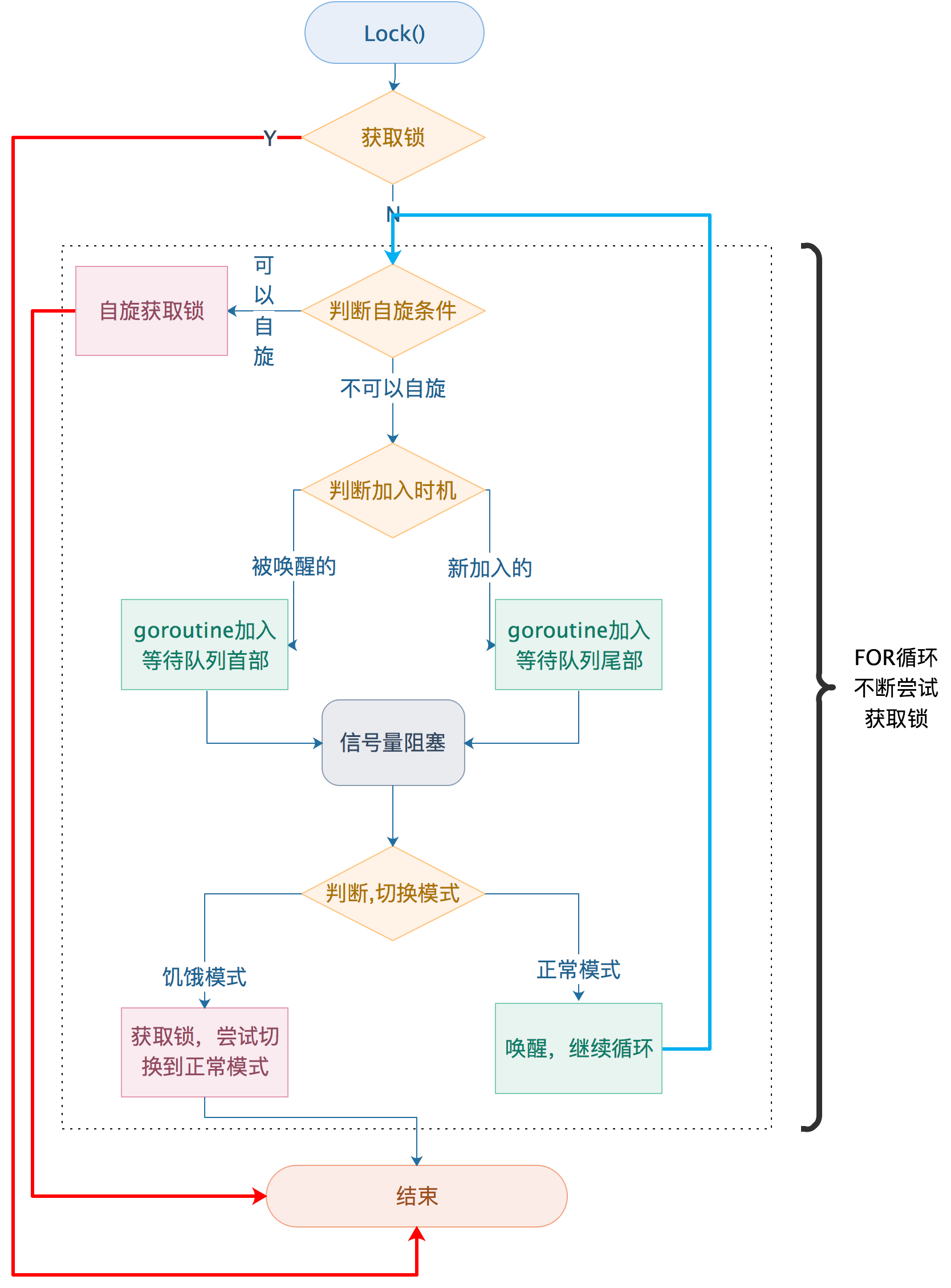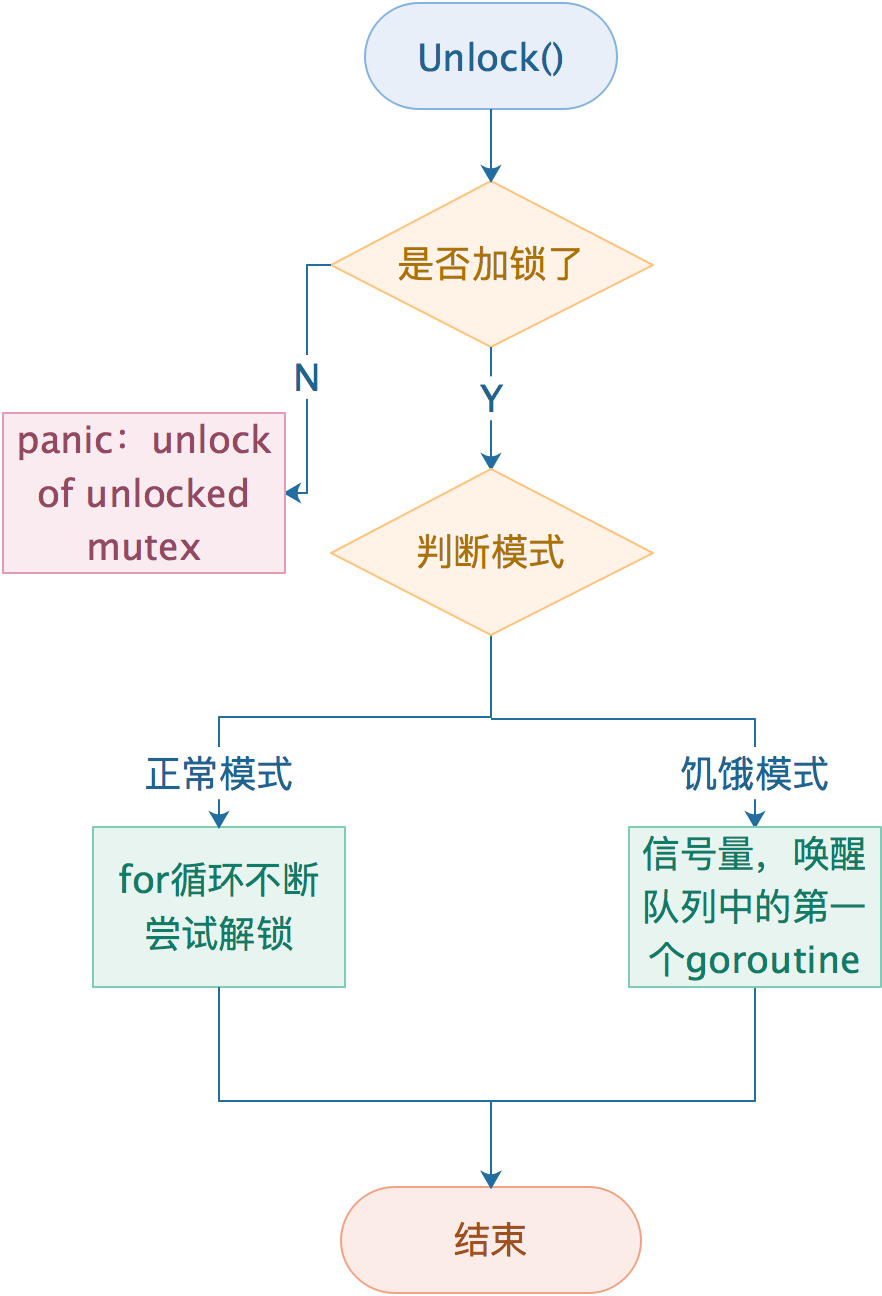并发必然会带来对于资源的竞争,这时需要使用go提供的sync.Mutex这把互斥锁来保证临界资源的访问互斥了。
锁的性质
在代码注释开篇就有一大段注释,里面讲了锁的设计理念。大致意思如下:
锁有两种模式:正常模式和饥饿模式。
在正常模式下,所有的等待锁的goroutine都会存在一个先进先出的队列中(轮流被唤醒)
但是一个被唤醒的goroutine并不是直接获得锁,而是仍然需要和那些新请求锁的(new arrivial)的goroutine竞争,而这其实是不公平的,因为新请求锁的goroutine有一个优势——它们正在CPU上
运行,并且数量可能会很多。所以一个被唤醒的goroutine拿到锁的概率是很小的。在这种情况下,
这个被唤醒的goroutine会加入到队列的头部。如果一个等待的goroutine有超过1ms(写死在代码中)
都没获取到锁,那么就会把锁转变为饥饿模式。
在饥饿模式中,锁的所有权会直接从释放锁(unlock)的goroutine转交给队列头的goroutine,
新请求锁的goroutine就算锁是空闲状态也不会去获取锁,并且也不会尝试自旋。它们只是排到队列的尾部。
如果一个goroutine获取到了锁之后,它会判断以下两种情况:
- 它是队列中最后一个goroutine;
- 它拿到锁所花的时间小于1ms;
以上只要有一个成立,它就会把锁转变回正常模式。
正常模式会有比较好的性能,因为即使有很多阻塞的等待锁的goroutine,
一个goroutine也可以尝试请求多次锁。
饥饿模式对于防止尾部延迟来说非常的重要。
字段定义
1
2
3
4
5
6
7
8
9
10
11
12
13
14
15
16
|
// A Mutex must not be copied after first use.
type Mutex struct {
state int32 // 锁的当前状态
sema uint32 // 信号量,用户唤醒goroutine
}
const (
// 是否加锁的标识
mutexLocked = 1 << iota // mutex is locked
mutexWoken
mutexStarving
mutexWaiterShift = iota
// Mutex fairness.
starvationThresholdNs = 1e6
)
|
state的状态:
- mutexLocked:对应低1位bit代表锁被占用,0标识锁空闲
- mutexWoken:对应低2位bit代表已唤醒,0标识未唤醒
- mutexStarving:对应低3位bit代表处于饥饿模式,0标识正常模式
- mutexWaiterShift:3(011),
m.state>>mutexWaiterShift得到当前阻塞的goroutine数目,最多可以阻塞2^29^个goroutine。

Lock
1
2
3
4
5
6
7
8
9
10
11
12
13
14
15
16
17
18
19
20
21
22
23
24
25
26
27
28
29
30
31
32
33
34
35
36
37
38
39
40
41
42
43
44
45
46
47
48
49
50
51
52
53
54
55
56
57
58
59
60
61
62
63
64
65
66
67
68
69
70
71
72
73
74
75
76
77
78
79
80
81
82
83
84
85
86
87
88
89
90
91
92
93
94
95
96
97
98
99
100
101
102
103
104
105
106
107
108
109
110
111
112
113
114
115
116
117
118
119
120
121
122
123
124
125
126
127
128
|
func (m *Mutex) Lock() {
// Fast path: grab unlocked mutex.
// 判断是否可以加锁。
// 第一个可以直接加锁返回
if atomic.CompareAndSwapInt32(&m.state, 0, mutexLocked) {
return
}
// Slow path (outlined so that the fast path can be inlined)
m.lockSlow()
}
func (m *Mutex) lockSlow() {
var waitStartTime int64
// 饥饿模式
starving := false
// 协程唤醒
awoke := false
// 循环次数
iter := 0
// 当前锁状态
old := m.state
for {
// Don't spin in starvation mode, ownership is handed off to waiters
// so we won't be able to acquire the mutex anyway.
// 条件一:old被获取到锁,但不处于饥饿状态。如果处于饥饿状态,锁的所有权直接交给等待队列第一个
// 条件二:可以自旋,多核、压力不大并且在一定次数内可以自旋。sync_runtime_canSpin的实现
if old&(mutexLocked|mutexStarving) == mutexLocked && runtime_canSpin(iter) {
// Active spinning makes sense.
// Try to set mutexWoken flag to inform Unlock
// to not wake other blocked goroutines.
// 自旋过程中如果发现state没有设置唤醒标识,添加awoke标识,并标记自己已唤醒
if !awoke && old&mutexWoken == 0 && old>>mutexWaiterShift != 0 &&
atomic.CompareAndSwapInt32(&m.state, old, old|mutexWoken) {
awoke = true
}
// 主动自旋
runtime_doSpin()
iter++
old = m.state
continue
}
// 到了这一步:state的状态可能是
// 1、锁没有释放,锁处于正常状态(011)
// 2、锁没有释放,锁处于饥饿状态(111)
// 3、锁已经释放,锁处于正常状态(010)
// 4、锁已经释放,锁处于饥饿状态(110)
// 复制一个新的状态
new := old
// Don't try to acquire starving mutex, new arriving goroutines must queue.
// 如果不是饥饿状态,new设置锁,尝试获取锁
// 如果处于饥饿状态,不设置状态
if old&mutexStarving == 0 {
new |= mutexLocked // 标记为获取锁(实际上还没有获取到)
}
// 如果old锁处于被获取或饥饿状态,就把期望状态的等待队列的等待者数量+1
if old&(mutexLocked|mutexStarving) != 0 {
new += 1 << mutexWaiterShift
}
// The current goroutine switches mutex to starvation mode.
// But if the mutex is currently unlocked, don't do the switch.
// Unlock expects that starving mutex has waiters, which will not
// be true in this case.
// 如果处于饥饿状态,并且state已经被加锁,将new state标记为饥饿状态
if starving && old&mutexLocked != 0 {
new |= mutexStarving
}
if awoke {
// The goroutine has been woken from sleep,
// so we need to reset the flag in either case.
// goroutine已经被唤醒,因此需要reset
if new&mutexWoken == 0 {
throw("sync: inconsistent mutex state")
}
// 设为未唤醒状态
new &^= mutexWoken
}
// 原子更新state
if atomic.CompareAndSwapInt32(&m.state, old, new) {
// 如果old状态不是饥饿状态也不是被获取状态,代表当前goroutine已经获取了锁
if old&(mutexLocked|mutexStarving) == 0 {
break // locked the mutex with CAS
}
// If we were already waiting before, queue at the front of the queue.
// 如果之前在等待了,就排在队列前面
queueLifo := waitStartTime != 0
// 如果没有等待过,初始化等待时间
if waitStartTime == 0 {
waitStartTime = runtime_nanotime()
}
// 如果queueLifo为true,将等待服务方针等待队列队头,被阻塞
runtime_SemacquireMutex(&m.sema, queueLifo, 1)
// 阻塞被唤醒
// 如果是饥饿状态或等待超过1ms,将当前goroutine状态设置为饥饿
starving = starving || runtime_nanotime()-waitStartTime > starvationThresholdNs
old = m.state
// 如果是饥饿状态
if old&mutexStarving != 0 {
// If this goroutine was woken and mutex is in starvation mode,
// ownership was handed off to us but mutex is in somewhat
// inconsistent state: mutexLocked is not set and we are still
// accounted as waiter. Fix that.
if old&(mutexLocked|mutexWoken) != 0 || old>>mutexWaiterShift == 0 {
throw("sync: inconsistent mutex state")
}
// 当前的goroutine获取锁,waiter-1
delta := int32(mutexLocked - 1<<mutexWaiterShift)
// 如果当前goroutine不是饥饿状态或当前goroutine是队列中最后一个,退出饥饿模式,状态设为正常
if !starving || old>>mutexWaiterShift == 1 {
// Exit starvation mode.
// Critical to do it here and consider wait time.
// Starvation mode is so inefficient, that two goroutines
// can go lock-step infinitely once they switch mutex
// to starvation mode.
delta -= mutexStarving
}
atomic.AddInt32(&m.state, delta)
break
}
awoke = true
iter = 0
} else {
// cas不成功,说明没有成功获取到锁,更新old
old = m.state
}
}
}
|
加锁流程
1、原子判断是否可以加锁,如果当前锁没有被使用,当前goroutine获取锁,结束本次Lock操作
2、如果已经被别的goroutine持有了,启动一个for循环去抢占锁:
会存在两种状态的切换:饥饿状态和正常状态
如果一个等待的goroutine有超过1ms没有获取到锁,那么把锁转换为饥饿模式;
如果一个goroutine获取到锁后
- 1、它是队列中最后一个goroutine
- 2、它拿到锁花费的时间小于1ms
上面的两个只要有一个条件成立,就会把锁转为正常状态。
3、如果锁已经被其他goroutine持有了,但不是饥饿状态,并且满足自旋状态,当前goroutine会不断自旋,等待锁被释放
4、不满足自旋条件的goroutine,结束自旋状态
5、如果old.state不是饥饿状态,新的goroutine会去尝试获取锁,如果是饥饿状态,就直接把锁交给等待队列的第一个
6、如果锁时被获取或饥饿状态,等待者数量+1
7、当本goroutine被唤醒了,要么持有锁,要么重新进入休眠状态
8、如果old.state的状态是未锁状态,并且锁不处于饥饿状态,那么当前goroutine已经获取了锁的拥有权,结束Lock
9、判断当前的goroutine是新来的还是刚被唤醒的,新来的加入到等待队列的尾部,刚被唤醒的加入等待队列的头部,然后通过信号量阻塞,直到当前goroutine被唤醒
10、判断如果当前state是否是饥饿状态,不是的唤醒本次goroutine,继续循环
11、是饥饿状态,当前goroutine设置锁,等待者-1,如果当前goroutine是队列中的最后一个,将锁设为正常状态,拿到锁结束Lock

UnLock
1
2
3
4
5
6
7
8
9
10
11
12
13
14
15
16
17
18
19
20
21
22
23
24
25
26
27
28
29
30
31
32
33
34
35
36
37
38
39
40
41
42
43
44
45
46
47
48
49
50
51
|
func (m *Mutex) Unlock() {
if race.Enabled {
_ = m.state
race.Release(unsafe.Pointer(m))
}
// Fast path: drop lock bit.
// 修改锁的状态
new := atomic.AddInt32(&m.state, -mutexLocked)
if new != 0 {
// 如果new=0,说明只有一个Lock并且被解开了
// Outlined slow path to allow inlining the fast path.
// To hide unlockSlow during tracing we skip one extra frame when tracing GoUnblock.
m.unlockSlow(new)
}
}
func (m *Mutex) unlockSlow(new int32) {
// (new+1)&1==0,new=-1,也就是上面已经Unlock后又调用一次Unlock会出现这种情况
if (new+mutexLocked)&mutexLocked == 0 {
throw("sync: unlock of unlocked mutex")
}
if new&mutexStarving == 0 {
// 不是饥饿状态
old := new
for {
// 如果锁没有等待拿锁的goroutine
// 或锁被获取了(在循环过程中被其他goroutine获取了)
// 或锁是被唤醒状态(表示有goroutine被唤醒,不需要再去尝试唤醒其他goroutine)
// 或者锁是饥饿状态(会直接交给队列头的goroutine)
// 那么直接返回
if old>>mutexWaiterShift == 0 || old&(mutexLocked|mutexWoken|mutexStarving) != 0 {
return
}
// Grab the right to wake someone.
// 将等待队列-1,设置woken标识
new = (old - 1<<mutexWaiterShift) | mutexWoken
// 设置新的state,通过信号量会唤醒一个阻塞的goroutine去获取锁
if atomic.CompareAndSwapInt32(&m.state, old, new) {
runtime_Semrelease(&m.sema, false, 1)
return
}
old = m.state
}
} else {
// 饥饿模式下,直接将锁的所有权转给等待队列中的第一个。
// 注意此时state的mutexLocked还没有设置,唤醒的goroutine会设置它。
// 在此期间,如果有新的goroutine来请求锁,因为mutex处于饥饿状态,mutex还会被认为处于锁的状态,新来的goroutine不会抢占锁
runtime_Semrelease(&m.sema, true, 1)
}
}
|
解锁流程
1、判断锁的状态,不能重复解锁
2、如果锁是正常模式,会不断尝试解锁
3、如果锁时饥饿模式,通过信号量,唤醒饥饿模式下Lock操作队列中第一个goroutine

总结
- 加锁过程会存在正常模式和饥饿模式的转换
- 饥饿模式是保证锁的公平性,正常模式下的互斥锁能提供更好的性能,饥饿模式能避免goroutine由于陷入等待无法获取锁造成的高尾延迟
- 锁的状态切换,用的是位运算
- 一个已经锁定的互斥锁,只能被解锁一次
如果atomic可以保证原子性,那么和mutex有什么区别呢?
Mutexes are slow, due to the setup and teardown, and due to the fact that they block other goroutines for the duration of the lock.
Atomic operations are fast because they use an atomic CPU instruction, rather than relying on external locks to.
互斥锁其实是通过阻塞其他协程起到了原子操作的功能,而atomic是通过控制更底层的CPU指令,来达到值操作的原子性。
mutex类似于悲观锁,总是假设会有并发的操作要修改被操作的值,所以使用锁将相关操作放入临界区加以保护
而原子锁CAS趋向于乐观锁,总是假设被操作值未曾修改(与旧值相等),一旦确认就立即进行值替换。在值被频繁变更的情况下,CAS操作并不是容易成功需要不断尝试。



